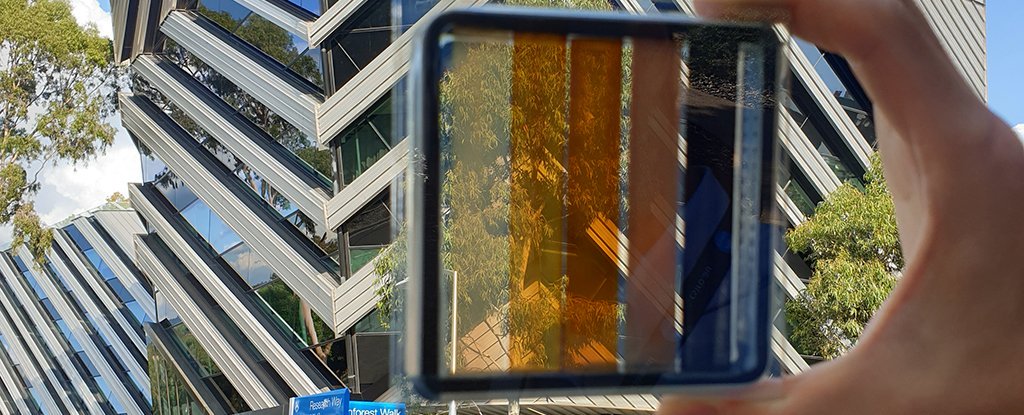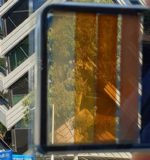Engineers have developed a semi-transparent solar cell that offers a viable level of efficiency, and it might get us closer to a future where windows that double up as solar panels could transform both architecture and energy production.
Two square metres (around 22 square feet) of the next-gen perovskite solar cells (PSCs) would be enough to generate about as much electricity as a standard solar panel, according to the latest study – in the region of 140 watts per metre, if tinted to the same degree as current glazed commercial windows.
Solar cell windows are something researchers have been working on for years, but as yet no one has really hit the sweet spot in terms of efficiency, stability and cost. The team behind the new project says they are closer than ever to doing just that.
“Rooftop solar has a conversion efficiency of between 15 and 20 percent,” says materials chemist Jacek Jasieniak, from Monash University in Australia. “The semi-transparent cells have a conversion efficiency of 17 percent, while still transmitting more than 10 percent of the incoming light, so they are right in the zone.

“It’s long been a dream to have windows that generate electricity, and now that looks possible.”
Central to the work is the replacement of a key solar cell component (Spiro-OMeTAD to be technical) with a specially developed polymer, based on an organic semiconductor, which increases overall stability.
That stability is crucial in material that is out in the sunshine all day. Add the recent efficiency increases in PSCs and you can see why this growing solar technology is becoming more and more commercially attractive.
However, you won’t be able to gaze through a perfectly clear window and get the maximum amount of energy efficiency from it – there’s still a balance to be found between opacity and efficiency.
“There is a trade-off,” says Jasieniak. “The solar cells can be made more, or less, transparent. The more transparent they are, the less electricity they generate, so that becomes something for architects to consider.”
Even with this major step forward, it may be some time – maybe as much as 10 years – before the tech can be commercialised and scaled up. The scientists are working with business partners to try and get the solar cells included in future building plans.
Multi-storey buildings where glazing is already expensive are likely to be the first beneficiaries, according to the team, as the addition of solar cell technology won’t cost a huge amount extra (and don’t forget the electricity savings).
Among the avenues that the researchers are now exploring is combining a layer of perovskite solar cells with a layer of organic solar cells (the more traditional type) to get the benefits of both.
“These solar cells mean a big change to the way we think about buildings and the way they function,” says Jasieniak.
“Up until now every building has been designed on the assumption that windows are fundamentally passive. Now they will actively produce electricity.”








 Photographer Finds Locations Of 1960s Postcards To See How They Look Today, And The Difference Is Unbelievable
Photographer Finds Locations Of 1960s Postcards To See How They Look Today, And The Difference Is Unbelievable  Hij zet 3 IKEA kastjes tegen elkaar aan en maakt dit voor zijn vrouw…Wat een gaaf resultaat!!
Hij zet 3 IKEA kastjes tegen elkaar aan en maakt dit voor zijn vrouw…Wat een gaaf resultaat!!  Scientists Discover 512-Year-Old Shark, Which Would Be The Oldest Living Vertebrate On The Planet
Scientists Discover 512-Year-Old Shark, Which Would Be The Oldest Living Vertebrate On The Planet  Hus til salg er kun 22 kvadratmeter – men vent til du ser det indvendigt
Hus til salg er kun 22 kvadratmeter – men vent til du ser det indvendigt  Superknepet – så blir snuskiga ugnsformen som ny igen!
Superknepet – så blir snuskiga ugnsformen som ny igen!  Meteorite That Recently Fell in Somalia Turns Out to Contain Two Minerals Never Before Seen on Earth
Meteorite That Recently Fell in Somalia Turns Out to Contain Two Minerals Never Before Seen on Earth  Nearly Frozen Waves Captured On Camera By Nantucket Photographer
Nearly Frozen Waves Captured On Camera By Nantucket Photographer  It’s Official: Astronomers Have Discovered another Earth
It’s Official: Astronomers Have Discovered another Earth 